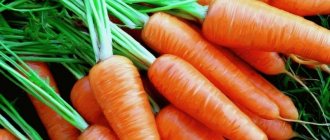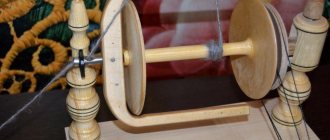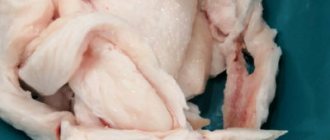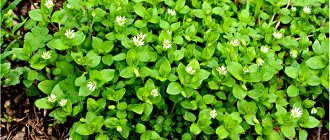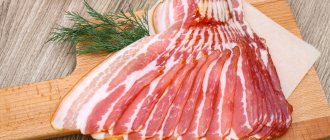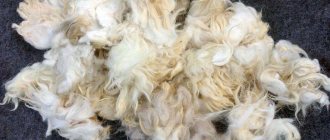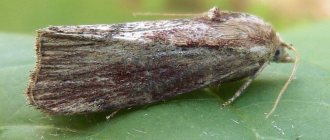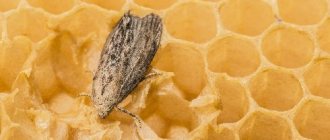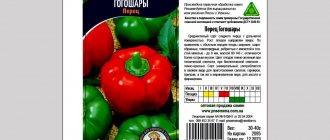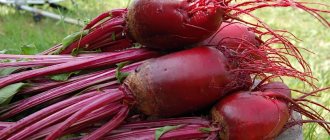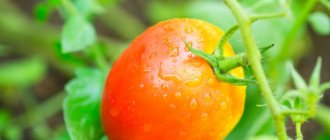Description of the species
Red onion is a type of onion . Its main characteristics are the unusual color of the husk and a sweeter taste than regular onions. The flesh remains white.
The turnips are small in size, soft, taste juicy and tender . There is no characteristic bitterness. Depending on the variety, the vegetable can be sweeter or less.
The homeland of red onions is Central Asia . Later, employees of the Nikitsky Botanical Garden in Crimea made a great contribution to the emergence of new varieties with excellent taste characteristics.
Varieties
Most plants are found in the middle climate zone.
They are divided into the following groups:
- sweet - suitable for eating even for children (from an adequate age);
- semi-sharp;
- spicy - have the sharpest taste.
Let's look at popular varieties of red onions with descriptions and photos.
Crimson Ball
Early maturing crop: harvested 80–95 days after sowing . Dark purple vegetables with a regular round shape are formed in 1 season.
The average weight of the bulbs is 80–90 g. The taste is semi-sharp.
The shelf life of the crop is short : only 4 months.
Greatful Red F1
The ripening time of the hybrid is average: 125 days from the date of sowing . The marketable yield is high: 276–650 centners are harvested from 1 hectare. In the Volgograd region, 850 c/ha were obtained. The crop is recommended for cultivation in the Lower Volga region.
The bulbs are large, dark red, weighing up to 120 g . The taste is semi-sharp and juicy.
Important! After ripening, the vegetables ripen completely.
The hybrid is resistant to fusarium rot . It has a high shelf life (stored until March).
Campillo F1
The hybrid produces bulbs that are round in shape, pale purple in color, and have a mild flavor . It grows both in the south and in central Russia.
The ripening period is medium-late (up to 150 days after planting).
Resistant to pink rot and fusarium . The harvest is stored without loss of taste until the next season.
Retro
The variety is late-ripening: 150 days pass after sowing before harvesting . Recommended for the Central region. The bulbs are dark red with white juicy pulp. They taste sweet. Up to 280 centners of vegetables are harvested from 1 hectare.
They are stored for only 3-4 months. Retro is resistant to fusarium and onion fly .
Yucont
Early variety: 85 days pass from the day of sowing to full ripening . Suitable for cultivation in the following regions:
- Central;
- Central Black Earth;
- Volgo-Vyatsky;
- Ural;
- West Siberian.
The bulbs are round, red with purple outlines . The taste is spicy.
In the annual crop, up to 210 c/ha of crops are harvested in the Central region, up to 120 c/ha in the Central Chernozem region, 212 c/ha in the Ural region, and up to 300 c/ha in the West Siberian region. Vegetables can be stored for up to 8 months .
Important! When grown from seeds, onions are harvested after a year, from sets - after 2.
The variety is resistant to fungal diseases.
Yalta
The most popular variety of red onion, as it is suitable for cultivation in all regions . Ripening time is average: up to 130 days from the date of sowing.
The bulbs are wide red . The pulp is juicy and white, sweet in taste.
The yield of Yalta onions is high: up to 500 centners are collected from 1 hectare. The crop is susceptible to onion fly attacks .
Chemical composition
Red onion contains the following beneficial elements::
- boron;
- cellulose;
- sulfur;
- iron;
- iodine;
- calcium;
- potassium;
- magnesium;
- sodium
- fluorine;
- chromium;
- chlorine.
The vegetable has low calorie content : 40 kcal per 100 g.
The pulp and juice contain anthocyanins - coloring substances, flavonoids that reduce inflammation and prevent cell damage due to oxidation in the intestines.
Onions contain phytoncides - substances that have a detrimental effect on pathogenic fungi and microorganisms.
Characteristics of the bulb
The whole bulb, except for the roots, is used for food.
Important! Some varieties have multi-layered feathers and reach a height of 1.5 m.
Depending on the variety, turnips can be wide, round or oval . Consists of numerous layers of juicy scales. The color changes from soft red to purple.
What does a red (blue) onion look like?
Red onions are a common variety of onions. It originated in Central Asia and spread to southern European countries, including Portugal, from where it came to Crimea. Therefore, red onions are often called Crimean or Yalta, although in fact this is only one of many varieties.
Externally, turnips have approximately the same shape and size as regular yellow or white onions. They differ in color and taste:
- The first two dry scales are colored a rich bluish-violet color. That's why many varieties of red onions are called blue.
- The pulp itself is reddish-violet, the color alternates with white, thanks to which the root vegetable looks very beautiful when sliced.
- Red onions have a sweeter and less pungent taste. At the same time, its aroma is no different from onion. Since the taste is milder, many types of red onions are used in salads and fresh cold appetizers, without prior treatment with boiling water.
Advantages and disadvantages
Main benefits of red onion:
- high content of useful substances;
- many varieties are suitable for cultivation in almost any region;
- mild taste without bitterness;
- high yield and keeping quality of some varieties.
Vegetables are demanding in terms of harvest time and storage conditions.
Onions are not eaten when:
- kidney diseases;
- disorders of the liver;
- inflammation of the intestines;
- stomach ulcer;
- individual intolerance;
- pregnancy;
- breastfeeding.
Differences from other types of onions
The main feature of red onion is the color of its peel . It comes in both soft pink and rich dark shades. Almost all varieties have excellent taste, juicy, tender and sweet.
Some plants (for example, Greatful Red) have increased shelf life and resistance to transportation, while others (Campillo) have strong immunity to diseases.
Beneficial properties of red onion:
- Anti-inflammatory - helps the body fight inflammation and infections.
- Antiseptic - disinfects the skin, kills pathogenic bacteria.
- Secretory - promotes the production of acid in the stomach.
- Anthelmintic - makes the environment unfavorable for parasites.
The vegetable improves blood circulation and dilates blood vessels . Thanks to its high sulfur content, it improves the condition of skin, hair and nails.
Take note:
Is it possible to fry red onions instead of white?
Best recipes: how to pickle red onions
"Bamberger"
This variety needs to be planted in soil rich in nutrients. Quite resistant to frost, but do not start planting in the ground at -12 ° C. Before planting, warm up the seed or soil well. Suitable for planting in winter, three weeks before frost. Appearance:
- oblong round shape;
- weight – 80 g;
- set size – up to 4 cm, harvest size – up to 8 to 11 cm;
- color – dark shade of gold.
Very juicy inside. In terms of taste, it is classified as a sweet variety, but there is a very slight pepperiness. Convenient for cutting, easy to clean. Ideal for both raw consumption and frying or canning. It can be stored at home for a long time and does not spoil.
Features of planting and growing
The culture is demanding in terms of light and humidity . The richest harvest of large bulbs ripens in sunny, well-moistened areas.
Is it possible to plant on the head before winter?
Although red onions prefer warm climates, some varieties (for example, Robin, Black Prince) are planted before winter .
Sowing time depends on the region : in the southern regions it is November, and in the northern regions it is September. Suitable ground temperature does not exceed +5°C.
Winter planting technology:
- Choose an open sunny area with well-drained soil. The earth is dug up with humus, mineral fertilizers, and ash.
- As soon as the soil settles, the area is leveled with a rake, furrows are made 6 cm deep. The distance between them is 20 cm.
- The sets are planted 8 cm apart.
- The soil is sprinkled and compacted.
- Water only after 10 days.
- As soon as frost sets in, the ground is mulched with straw.
Some gardeners plant several varieties at once to choose the one they like and prepare it for next year. This procedure will help determine the most winter-hardy onions.
Preparing for landing
Planting material is pre-soaked in a weak solution of potassium permanganate (pink) for 30 minutes. This will destroy pathogens. To speed up germination, the seeds are treated with a growth stimulant and placed in a canvas bag.
Soil requirements
The site for planting is chosen to be well-lit, with fertile soil (pH 7). If the soil is acidic, add dolomite flour.
Attention! The crop grows best in the place where cabbage was before.
The following fertilizers are applied for digging (per 10 liters of water):
- urea - 2 tbsp. l.;
- rotted chicken droppings - 100 g;
- manure infusion - 1 l.
Dates, scheme and rules of planting
The prepared material is planted in open ground 2 days after treatment , when constant warm weather has established (+22...+23°C) and the soil has warmed up well.
Planting depth : 1.5 cm. Pattern: 3x10 cm.
The seedlings are planted in furrows 5 cm apart . The distance between furrows is 24 cm.
Features of cultivation
In northern latitudes, early ripening varieties are cultivated . For planting, use seedlings or seedlings. These vegetables have a bitter taste.
Onions with medium ripening periods are suitable for the central strip . Seedlings are used as planting material.
In the southern climate, on fertile soil, all varieties grow . The taste of this onion is sweet or semi-sweet.
Nuances of care
Caring for red onions is standard . Watering is carried out as the top layer of soil dries, fertilizing - 2 times per season.
Advice! For long-term storage of the crop, the feathers of the plants are not trimmed.
Watering mode
Red onions are watered once every 7 days, at the rate of 5–10 liters of water per 1 m2 . At the same time, pay attention to weather conditions. If the summer is dry and the feathers begin to dry out, the frequency of irrigation is increased to 2 times a week. In rainy weather, watering is stopped.
In July, when turnips begin to ripen , the crop is moistened once every 14 days.
Watering is stopped completely 2 weeks before harvest : the vegetables are allowed to dry so that they do not rot during storage.
Loosening and weeding
Loosen the soil shallowly until the stems close together.
Weeding is carried out regularly : weeds take nutrients from plants.
Top dressing
Fertilize the crop twice per season:
- When forming bulbs, organic compounds are used. Prepare a solution of chicken manure (1:10) or liquid mullein (1:5).
- At the end of June, a composition of 10 liters of water, 60 g of superphosphate, 30 g of sodium chloride is applied to the root. The resulting volume is enough for 2 m2.
Disease and pest control
Most often, red onions are susceptible to a fungal disease - fusarium . It manifests itself as softening of the bottom of the head and death of the roots. The leaves turn yellow and the plant dies. Affected bushes cannot be treated; they are dug up and burned. For prevention, seedlings are soaked in fungicide for 30 minutes before planting.
In dry summers, plants are attacked by onion fly . She appears as soon as the dandelions begin to bloom. Insect larvae penetrate the vegetable through the bottom or base of the leaves, eating it from the inside. Tobacco is used to control the pest. It is mixed with water at the rate of 250 g per 10 liters, left for 2 days. The resulting product is sprayed onto the plants. For 1 m2 you will need 1 liter of composition.
Hot, semi-sharp, sweet onions - looking for differences
All hot onion varieties are early ripening. They have good shelf life, a high content of essential oils and sugars, but at the same time they are less productive. Such varieties, as a rule, are covered with several layers of outer scales, and therefore they can be removed not only manually, but also with the help of specialized equipment.
Semi-sharp onion varieties have few external scales, and the flesh is not so dense and sharp. When harvested with special equipment, such onions are often injured and quickly become unusable. Peninsular varieties are considered medium-ripening and require more time to ripen. However, they produce a higher yield than spicy varieties.
Sweet onions have a wonderful taste and are often used fresh. They produce a high yield, but it is stored for a short time. Hot and semi-sharp varieties of onions can be grown in any region. In the southern regions, during the growing season the harvest can even be obtained from seeds. And in the middle zone and northern zones - only through seedlings or by planting sets. Sweet varieties are grown mostly from seeds in hot southern regions.
Harvest and storage
Red onions are demanding in terms of harvesting time and storage conditions. It is much more difficult to store than ordinary bulbs .
Vegetables ripen in late July - early August . As soon as the neck becomes dry and most of the feathers turn yellow and dry, the onion is ready.
Attention! Harvesting is carried out in warm sunny weather.
Store red onions in boxes or on special racks . The humidity in the room should be about 65%, the temperature should not exceed +19°C.
Varieties of this variety have high keeping quality . Some (Grateful Red, Campillo, Yucont) are stored until the new season.
"Alpha"
A fairly strong variety in terms of resistance to viruses and various diseases, which cannot be said about resistance to frost. The vegetable ripens early and quite quickly: it can be planted in May, and a stable harvest can be harvested after 70 days. Therefore, it is considered an early ripening variety. External characteristics:
- round form;
- golden crust in five layers;
- weight up to 120 g;
- leaf height – up to 30 cm.
- The size of the set is small, which is why it can freeze quickly.
Has a pungent taste, ideal for canning and raw
. They need to be planted at intervals of 10 cm in rows, the distance between which is no more than 30 cm, as for all other varieties of onion sets.
Reviews
Red onions are popular among farmers in various regions. It is grown for both food and cosmetics .
Anna, Krasnodar region, Yeisk : “I plant Yalta onions in the garden along with carrots. The harvest is strong and lasts a long time. I use it for making salads and preserves.”
Victor, Moscow region, Krasnoarmeysk : “I have been growing the Red Baron variety for 2 years now. The turnips turn out to be large and dense. Great for barbecue and fish. The productivity is very high, and the crop is unpretentious in maintenance.”
Daria, Vladimir region, Alexandrov : “I use red onions not only in cooking, but also for preparing various cosmetics: hair masks, decoctions. The smell is not as strong as the white one. The effect is amazing."
"Corrado"
Onion sets “Corrado” are very popular, the description of the variety can be reduced to several important advantages:
- stored for a whole year, until the next harvest;
- early variety - ripens from 73 to 93 days;
- gives a stable large harvest.
Long-term storage is achieved thanks to the very dense double husk. It is important to store in a room with good air circulation at a temperature of at least 15 °C. The color is golden and brown, the onion weighs up to 130 g, and the taste is semi-sharp.
"Roseanne"
This onion variety is early and produces a good harvest three months after planting the set, for which it is highly valued. Steadily produces up to 3 kg per square meter. It is planted in the spring, when the temperature is not lower than 10 °C. During this period, the soil is quite moist, which is what “Roseanne” requires. Autumn planting is possible three weeks before the onset of frost. The vegetable tastes medium spicy, white, dense and juicy inside. The outside of the onion is covered with pink husk.
"Rosanna" is included in the list of popular varieties of onion sets due to its size. The round onion is quite large, with an average diameter of 8 cm. Weight ranges from 120 g.
For Siberia
In order to grow sweet onions in harsh weather conditions, it is important to select varieties that will be adapted to the cold. Some of the most popular varieties of onions in Siberia are:
- Exhibition.
This variety is considered a salad variety and was bred in America. Exhibition onions grow very large; one fruit can reach from 500 g to 1 kg of weight. The bulbs are oval in shape, with an elongated end. The fruits are stored for 5 months without losing their taste and beneficial properties.
- Globo.
Has a fairly high yield. The fruits are dense, yellow in color. The weight is also quite large: from 500 g to 1 kg per fruit. Inside the vegetable there is a sweetish and soft pulp. When grown, it does not require special care conditions and is disease resistant.
- Sterling F1.
Developed by the Dutch. Refers to mid-season onions. The fruits are round in shape, white in color, weighing up to 850 g. Subject to long-term storage, resistant to root rot.
"Stardust"
The Stardust onion is very popular among the people, the ripening time of which is on average 60 days. The only variety from this list that has a white color. Planting is done in the first week of May. This variety can bring you more than 5 kg of snow-white bulbs per square meter.
The shape is round and smooth. The weight is small, up to 60 g. The onion tastes a little spicy, which is why it is valued in the kitchen when eaten fresh. It is stored for 6 months after harvest at a constant warm temperature. If the condition is not met, arrows are likely to appear.
Benefit for health
The health benefits of red onions have long been proven. It has a powerful anti-inflammatory effect: the juice of the vegetable fights bacteria, and various substances in the composition can destroy the shell of viruses, in particular the influenza virus. Onions have an antiseptic effect on the oral cavity and respiratory tract.
Red onions are often used as a cough suppressant for bronchitis or pulmonary diseases. To do this, half a kilogram of onion is cut, mixed with two tablespoons of sugar, a teaspoon of honey and poured with a liter of water. The liquids are allowed to brew for an hour, and then consumed a tablespoon three times a day after meals.
Red onion has a pronounced secretory effect: it can increase acidity, enhancing the functioning of the digestive glands.
Onions have been proven to improve blood circulation. It dilates blood vessels, lowers cholesterol levels in the blood, preventing the formation of vascular plaques with subsequent narrowing of the lumen of blood vessels.
Red onion is used to treat the thyroid gland. The thyroid gland responds well to compresses from this vegetable. To make such a compress, take 0.5 kg of onion and grind it thoroughly in a blender. The resulting substance is applied to gauze folded in several layers and applied to the neck. The top of the gauze is covered with oilcloth or a plastic bag and wrapped with a scarf. You need to keep the compress for two hours. It is recommended to perform the procedure 2 times a week for a month.
Nutritionists have proven that red onions are effective for type 2 diabetes. The study found that regular consumption of onions leads to a decrease in blood sugar levels. Moreover, onions can be consumed to prevent diabetes.
Recipes that require the use of red onions with sugar to treat the liver are popular in folk medicine. It is believed to be able to remove toxins and improve the flow of bile. To prepare the medicinal mixture, take half a kilogram of red onion, cut it and grind it in a blender. The onion is mixed with 400 g of sugar, transferred to a clean glass container and sent to a cool place out of reach of sunlight for 10 days. After this time, the onion is carefully squeezed out and thrown away, and the resulting juice is drunk daily, 3 tablespoons half an hour before meals.
The standard course of use of this traditional treatment method is 1-3 weeks. This recipe will help in the treatment of hepatitis, liver cirrhosis and cholecystitis.
Red onion has a general strengthening effect: it increases the body’s immunity and resistance to viruses and bacteria, helps reduce the risk of allergic reactions, normalizes the functioning of the nervous system, eliminates anxiety and fights irritability.
For women
For women, red onion is useful because it:
- increases immunity;
- normalizes the functioning of the nervous system;
- prevents the development of breast and female genital cancer;
- is a component in cosmetological body care;
- During pregnancy, red onions are an excellent source of vitamins and minerals.
It is better for women during lactation to avoid eating onions, as their substances can penetrate into breast milk and irritate the baby’s stomach mucosa, causing colic.
For men
Red onion is effective for normalizing the functioning of the male reproductive system. It promotes the production of testosterone, increases libido, and fights sexual weakness. With regular consumption of onions, the activity and viability of sperm improves, and their ability to fertilize an egg increases.
For children
Red onions are very useful for children: they strengthen the immune system, reducing the risk of developing viral and bacterial infections that easily spread among children. The vegetable increases resistance to external stimuli and helps children adapt to a new environment.
For children with allergies, eating red onions will reduce the risk of developing allergic reactions.
Important! The greatest need of a child’s body for vegetables occurs during the period of teeth change. At this time, red onion promotes the normal formation of bone tissue, which will prevent tooth loss and destruction in the future.
"Centurion"
Outwardly it differs from others, because it has an egg shape. The color of the husk is light yellow. It tastes very spicy. Its main feature is productivity. "Centurion", along with "Hercules", is capable of bringing 8 kg of onions per square meter.
According to its characteristics, among gardeners, this variety is considered to be of very high quality and reliable. Three months after planting, you can harvest a good harvest. The product should be stored in a cool place, but with good air circulation.
Useful properties for beauty
Red onion is famous for its beauty benefits. It is used by people who want to lose weight, and girls actively add it to various masks for face and hair care.
Weight loss
Red onion is actively used for weight loss. It activates metabolic processes in the body, naturally speeding up metabolism. The vegetable improves overall well-being, normalizes energy consumption processes, which together leads to excess weight loss.
Those who want to lose weight are recommended to add red onions to their food (in salads, soups or as an addition to main dishes).
Facial care
For many women, facial care is not complete without adding onions. For example, it helps in the fight against age spots (see video).
For oily skin
For oily skin, use a mask of squeezed juice of 2 onions mixed with a tablespoon of lemon juice. The mixture is applied to the face for 15-20 minutes and washed off with warm water, and then washed with cold water. This mask normalizes the functioning of the sebaceous glands, fights acne, having an antimicrobial effect on the causative agent of the disease, eliminates oily sheen and minor redness.
For dry skin
To nourish dry skin, prepare a mixture of a teaspoon of onion juice and cucumber juice. They are mixed and 250 ml of chilled boiled water is added. The resulting liquid is applied to a sponge and wiped over the skin of the face.
With regular treatment, the skin will become more hydrated, elastic, and the complexion will be evened out.
For wrinkles
Since red onion is a powerful antioxidant, it is used to prevent and remove fine lines and wrinkles. To do this, prepare a mixture of equal amounts of onion juice, honey, white lily juice and white wax. The mixture is heated over low heat until the ingredients dissolve, cool, apply to the face for 60 minutes, and then rinse with warm water.
Against freckles
Those who are embarrassed by freckles on their face can prepare a mask from red onions to remove them.
To do this, pour a teaspoon of calendula into 100 ml of boiling water and leave for half an hour. Then add a teaspoon of onion juice to the liquid and wipe your face with the resulting solution 3-4 times a day. This composition has a pronounced whitening effect; over time, freckles become less noticeable.
Hair care
Hair care is greatly simplified thanks to masks with the addition of red onion.
For oily hair
For oily hair, you can prepare a mask from 2 tablespoons of onion juice and the same amount of castor oil. This mixture is rubbed into the scalp, left for half an hour, and then washed in the usual way. This mask normalizes the functioning of the sebaceous glands of the head, helps to better flush out sebum and strengthens the hair follicles.
For hair loss
A mask made from onion juice and honey, taken in equal proportions, will help with hair loss. It is rubbed into the scalp every day for a month. After just two weeks, you can see a decrease in hair loss.
For dandruff
A mask made from a tablespoon of onion juice and two tablespoons of vodka will help in the fight against dandruff. It is rubbed into the scalp for 60 minutes, and then washed with shampoo. This mask reduces the activity of the sebaceous glands and has a bactericidal effect on fungi that cause dandruff.
"Stuttgarter Riesen"
Together with “Sturon”, “Hercules” and “Centurion” it is included in the list of the best varieties of onion sets for the middle zone. "Stuttgarter Riesen" is early, resistant to spring cold. It also has other advantageous characteristics:
- a little spicy, but great taste;
- weight from 150 to 300 g, and this is an excellent value for a bow;
- ripening period up to 90 days.
Externally, it has a rounded-flat or flat shape. Contains a lot of ascorbic acid. The shelf life of onions is quite long. This variety became the basis for the selection of many new, improved varieties.
Did you know? Farmer Peter Glazebrook from the UK managed to grow the largest onion in the world - as much as 8.2 kg!
"Rumba"
The fairly large, round bulbs weighing between 100 and 120 g have a brown husk that covers a white, juicy interior with a tangy taste. Planting is done in May in fertilized soil and awaits the month of July, when it will be possible to harvest the crop - up to 5 kg per square meter of land. The seedlings tolerate unfavorable weather conditions well. Such qualities are very impressive, thanks to which the Rumba bow has become very popular.
"Red Baron"
This is a fairly early variety of onion set that tolerates cold spring well. So, already at the end of May you will be able to collect vegetables. It is necessary to constantly water and loosen the soil. Good care and mineral-rich soil will bring you a yield of up to 3 kg per square meter.
A true keeper of vitamin C, Red Baron has made its mark in the kitchen, especially in salads. Chefs prefer this variety for its semi-sharp taste and shelf life. It is dark red in color, round in shape, moderately juicy and dense inside.
Onion sets "Red Baron", the description of the variety speaks of its high productivity, practicality and usefulness, can be planted in the garden of mid-latitudes.
